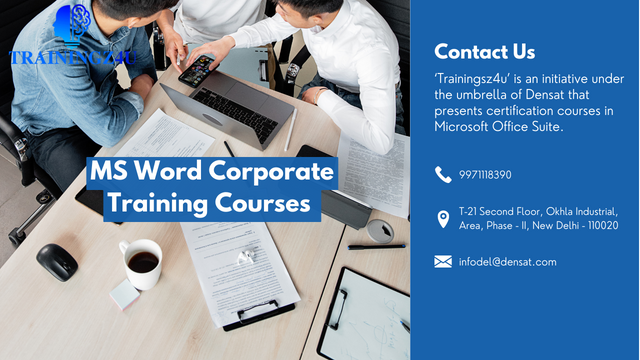Microsoft Word, which is sometimes called MS Word, is a well-known word processing program that is most often used to make documents like brochures, letters, learning activities, quizzes, tests, and homework assignments for students. Microsoft Word is frequently referred to as "MS Word." Word is often considered to be among the most widely used and well-known pieces of office software all over the world. Over time, it has grown in both power and complexity, and the addition of Office 365 and Microsoft One Drive has increased its flexibility to meet the needs of a wider range of businesses, from large corporations to sole proprietorships.
Trainingz4u provides the following MS Word trainings:
MS BASIC TRAINING ➜
MS MID-LEVEL TRAINING➜
MS ADVANCE TRAINING ➜
MS CUSTOMIZED TRAINING➜
https://trainingz4u.com/ms-word-training/
• The Ecosystem of Microsoft Word
A wider collection of software products includes Microsoft Word as one of its components. This set also includes spreadsheet and presentation software Excel and PowerPoint. Office 365 is the collective name for Microsoft's collection of software programs, which includes Word as well as a number of other apps and programs.
Word's connection to the internet gives users the ability to create and save documents in the cloud, as well as the ability to create documents. Because of this, Word and the programmers who work with it have even more flexibility.
What kinds of things do you do using Microsoft Word at your company?
Here is a list of useful features in Microsoft Word that you can use to make your business more flexible and efficient:
Letters and mailings:
Businesses use Microsoft Word to handle their needs for letters and mailings that they send out. Mail merge features can use databases that you make in Word or other Office programs like Excel or Outlook. Then, these databases can be imported to make a letter template with already-filled-in contact and address information. You may use these functions to send out mass mailings. Word also has the ability to print address labels and envelopes, among other things.
Making documents and forms:
You can make any kind of business document, such as budgets, plans, proposals, corporate reports, and presentations. Among the other types of business documents that you can generate are: Because Word's design features are easy to understand and use, it won't be hard for you to make a large collection of important documents like notes, agendas, invoices, and statements.
https://trainingz4u.com/ms-powerpoint-training/
Creating marketing and promotional materials:
Word gives you the ability to produce marketing and promotional materials such as brochures, flyers, and newsletters that you can send out to potential customers and existing customers. In addition to that, you are able to create and print your own letterhead and business cards. This is especially helpful for smaller businesses that might have trouble paying a third party for printing and design services.
Strengthening of the firm's brand:
Make a standard format for letters or memos that everyone in the company can use, and then save it as a template. This guarantees that the color, typefaces, and effects will be consistent with one another. There is also the option of downloading free templates from Microsoft. Some of Microsoft's templates are put together in "style sets." This lets users use the same design on a variety of marketing materials, papers, and forms to keep their brand's look consistent.
Advanced Capabilities for Word Documents:
Word also has the following extra features that save you time and make it easier to do repetitive tasks: As a result, you are able to focus your attention on more important facets of the project.
Including Graphics:
One of the major benefits of using Microsoft Word is that it allows users to easily add graphics, such as images, drawings, and other visual elements, to help break up the monotony of the text. These items can have their locations inside a document changed by using the program's drag-and-drop features. It is also possible to add things made by other programmers, like a spreadsheet table, to a Word document you have made.
Spelling and grammar checks:
Word performs checks for spelling and grammar to ensure that the document you are working on is free of errors and professional in appearance. Additionally, it frequently provides alternative phrasing recommendations.
Making a Table of Contents:
The Table of Contents is useful when the user wants to give readers a visual guide by putting page numbers and links to different headings next to each other. This feature is perfect for times when the user wants to give readers a visual guide.
Auto-Formatting:
The Auto-Formatting feature in Microsoft Word lets users apply related styles to text as they type, so their documents are automatically formatted as they are made.
Instruments for Collaborative Work:
Business documents often have a lot of different parts, and each one is written by a different person. Additionally, both workers and managers might offer ideas for changes to be made to a document. The way Word works with One Drive and the internet makes the process easier to handle. The collaboration and review features of Word are especially helpful. Users are able to access the most recent version of a document that is hosted online, read the alterations that have been made to it by other reviewers, and make alterations either directly to the text itself or as comments that are shown apart from the main text.
